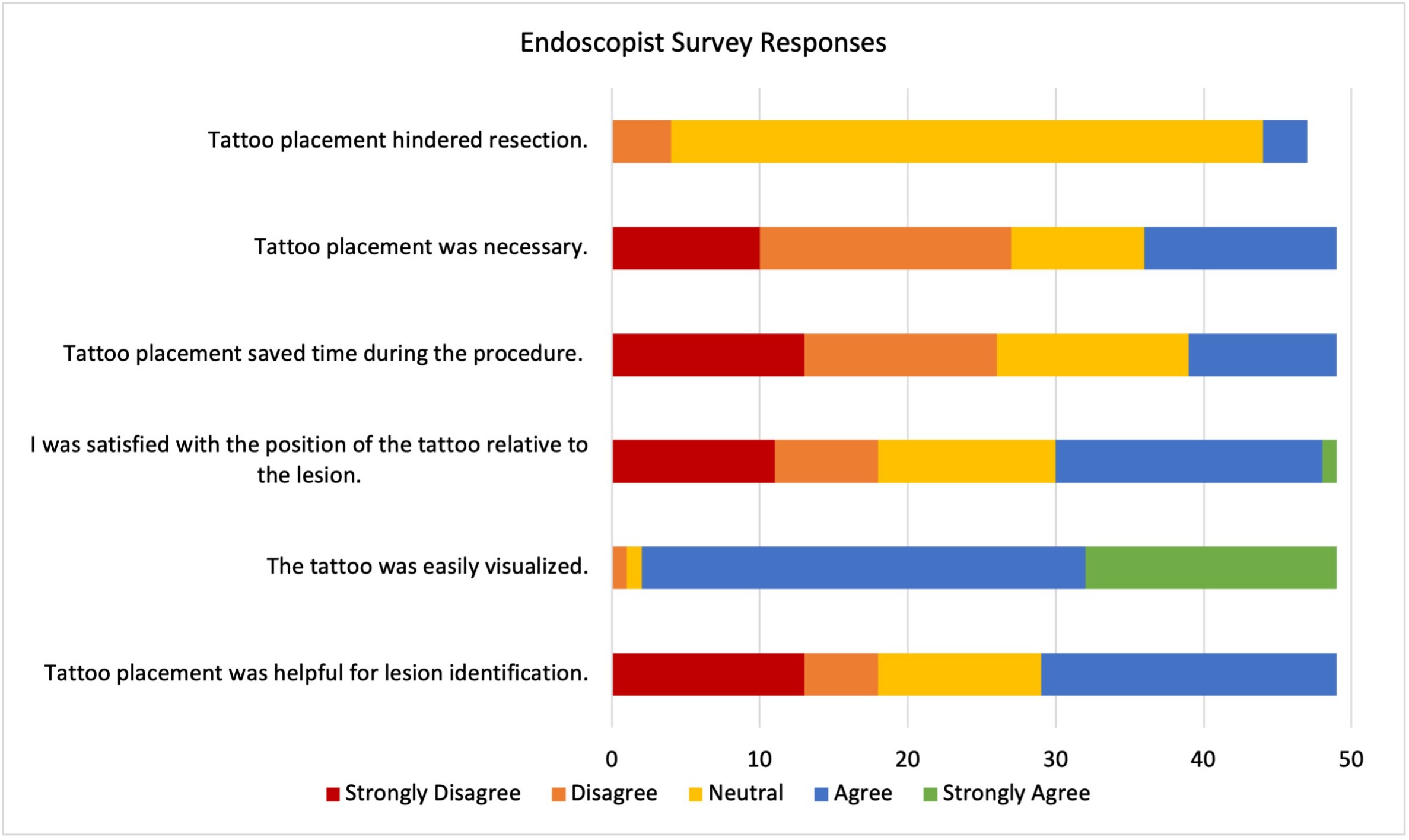Oral Paper Presentation
Annual Scientific Meeting
Session: Plenary Session 2B - Colon / General Endoscopy / GI Bleed / Practice Management
31 - Think Before You Ink: Endoscopist-Rated Utility of Tattoo Placement for Identifying Colorectal Polyps Referred for Endoscopic Resection – A Prospective Multicenter Study
Tuesday, October 29, 2024
9:00 AM - 9:10 AM ET
Location: Terrace Ballroom 2-3

Natalie Wilson, MD
University of Minnesota
Minneapolis, MN
Presenting Author(s)
Natalie Wilson, MD1, Rahul Karna, MD2, Mohanad Awadalla, MD3, Frances Dang, MD4, Ronald Turner, MD5, Roya Dastjerdi, MPH3, Markus Goldschmiedt, MD5, John G. Lee, MD4, Douglas Pleskow, MD3, Tyler M. Berzin, MD6, Shawn Shah, MD5, Thomas Tielleman, MD5, Jason Samarasena, MD4, Moamen Gabr, MD3, Mohammad Bilal, MD7
1University of Minnesota, Minneapolis, MN; 2University of Minnesota Medical Center, Minneapolis, MN; 3Beth Israel Deaconess Medical Center, Boston, MA; 4University of California, Irvine, Orange, CA; 5University of Texas Southwestern, Dallas, TX; 6Beth Israel Deaconess Medical Center, Harvard Medical School, Boston, MA; 7University of Minnesota and Minneapolis VA Health Care System, Minneapolis, MN
Introduction: The United States Multi-Society Task Force on colorectal cancer recommends tattoo placement for any large colorectal lesion referred for future endoscopic removal. However, the practice of tattoo placement remains highly variable, and it is unclear whether endoscopists performing advanced endoscopic resection (ER) find tattoo placement helpful. The aim of this study is to evaluate the utility of tattooing colorectal lesions as perceived by the endoscopist performing advanced endoscopic resection.
Methods: This is a prospective multicenter study of previously tattooed colorectal lesions that were referred for endoscopic resection. Data was collected between 2/27/24 and 6/15/24. Endoscopists performing ER of a previously tattooed polyp completed a 7-question, 5-point Likert scale survey which assessed the impact of tattoo placement on resection. Questions ranged from endoscopist perceived usefulness of tattoo placement to appropriateness of location of tattoo placement and impact on resection. Patient and procedural details were also recorded. Descriptive statistics were calculated using frequencies and percentages.
Results: A total of 49 polyps in 46 patients were referred for ER after tattoo placement. ER was performed by nine endoscopists across five institutions. Endoscopist number of years in practice ranged from one to 39 years with a median four years of experience. The average polyp size was 30.7 mm and most common locations were ascending colon (36.7%) and transverse colon (22.5%) [Table 1]. Polyp resection was previously attempted in 24.5% of cases and 20.8% had fibrosis or scarring. The previously placed tattoo involved the lesion in 19.6% of cases and was located < 3 cm from the lesion in 56.7% (21/37). Technical success was achieved in 91.3%.
Overall, 47% of endoscopists felt tattooing was not useful for lesion identification and was not necessary in 55.1% of cases. The position of the tattoo was rated as not satisfactory in 36.7%. Tattooing had no impact on the ease of resection in 85.1%, hindered resection in 6.4%, and facilitated resection in 8.5% [Figure 1].
Discussion: Our prospective evaluation suggests that tattoo placement may not be as useful as previously thought for colorectal lesion identification during colonoscopy, although this does not negate its potential role for surgical localization if advanced endoscopic resection fails. While guidelines recommend tattoo placement 3cm distant to polyps, we found that tattoo placement was too close in a majority of cases.


Disclosures:
Natalie Wilson, MD1, Rahul Karna, MD2, Mohanad Awadalla, MD3, Frances Dang, MD4, Ronald Turner, MD5, Roya Dastjerdi, MPH3, Markus Goldschmiedt, MD5, John G. Lee, MD4, Douglas Pleskow, MD3, Tyler M. Berzin, MD6, Shawn Shah, MD5, Thomas Tielleman, MD5, Jason Samarasena, MD4, Moamen Gabr, MD3, Mohammad Bilal, MD7, 31, Think Before You Ink: Endoscopist-Rated Utility of Tattoo Placement for Identifying Colorectal Polyps Referred for Endoscopic Resection – A Prospective Multicenter Study, ACG 2024 Annual Scientific Meeting Abstracts. Philadelphia, PA: American College of Gastroenterology.
1University of Minnesota, Minneapolis, MN; 2University of Minnesota Medical Center, Minneapolis, MN; 3Beth Israel Deaconess Medical Center, Boston, MA; 4University of California, Irvine, Orange, CA; 5University of Texas Southwestern, Dallas, TX; 6Beth Israel Deaconess Medical Center, Harvard Medical School, Boston, MA; 7University of Minnesota and Minneapolis VA Health Care System, Minneapolis, MN
Introduction: The United States Multi-Society Task Force on colorectal cancer recommends tattoo placement for any large colorectal lesion referred for future endoscopic removal. However, the practice of tattoo placement remains highly variable, and it is unclear whether endoscopists performing advanced endoscopic resection (ER) find tattoo placement helpful. The aim of this study is to evaluate the utility of tattooing colorectal lesions as perceived by the endoscopist performing advanced endoscopic resection.
Methods: This is a prospective multicenter study of previously tattooed colorectal lesions that were referred for endoscopic resection. Data was collected between 2/27/24 and 6/15/24. Endoscopists performing ER of a previously tattooed polyp completed a 7-question, 5-point Likert scale survey which assessed the impact of tattoo placement on resection. Questions ranged from endoscopist perceived usefulness of tattoo placement to appropriateness of location of tattoo placement and impact on resection. Patient and procedural details were also recorded. Descriptive statistics were calculated using frequencies and percentages.
Results: A total of 49 polyps in 46 patients were referred for ER after tattoo placement. ER was performed by nine endoscopists across five institutions. Endoscopist number of years in practice ranged from one to 39 years with a median four years of experience. The average polyp size was 30.7 mm and most common locations were ascending colon (36.7%) and transverse colon (22.5%) [Table 1]. Polyp resection was previously attempted in 24.5% of cases and 20.8% had fibrosis or scarring. The previously placed tattoo involved the lesion in 19.6% of cases and was located < 3 cm from the lesion in 56.7% (21/37). Technical success was achieved in 91.3%.
Overall, 47% of endoscopists felt tattooing was not useful for lesion identification and was not necessary in 55.1% of cases. The position of the tattoo was rated as not satisfactory in 36.7%. Tattooing had no impact on the ease of resection in 85.1%, hindered resection in 6.4%, and facilitated resection in 8.5% [Figure 1].
Discussion: Our prospective evaluation suggests that tattoo placement may not be as useful as previously thought for colorectal lesion identification during colonoscopy, although this does not negate its potential role for surgical localization if advanced endoscopic resection fails. While guidelines recommend tattoo placement 3cm distant to polyps, we found that tattoo placement was too close in a majority of cases.

Figure: Figure 1. Summary of Endoscopist Survey Responses on the Utility of Tattoo Placement in Colorectal Lesions Referred for Endoscopic Resection

Table: Table 1. Patient, polyp, and procedural details
Disclosures:
Natalie Wilson indicated no relevant financial relationships.
Rahul Karna indicated no relevant financial relationships.
Mohanad Awadalla indicated no relevant financial relationships.
Frances Dang indicated no relevant financial relationships.
Ronald Turner indicated no relevant financial relationships.
Roya Dastjerdi indicated no relevant financial relationships.
Markus Goldschmiedt indicated no relevant financial relationships.
John Lee indicated no relevant financial relationships.
Douglas Pleskow indicated no relevant financial relationships.
Tyler Berzin: Boston Scientific – Consultant. Magentiq Eye – Consultant. Medtronic – Consultant. RSIP Vision – Consultant. Wision AI – Consultant.
Shawn Shah indicated no relevant financial relationships.
Thomas Tielleman indicated no relevant financial relationships.
Jason Samarasena: Cook Medical – Consultant. Medtronic – Advisory Committee/Board Member, Consultant. Neptune Medical – Advisory Committee/Board Member, Consultant. Olympus – Advisory Committee/Board Member, Consultant. Ovesco – Advisory Committee/Board Member, Consultant, Speakers Bureau. SatisfAI – Stock-privately held company. Steris – Advisory Committee/Board Member.
Moamen Gabr indicated no relevant financial relationships.
Mohammad Bilal: Boston Scientific – Consultant. Cook endoscopy – Speakers Bureau.
Natalie Wilson, MD1, Rahul Karna, MD2, Mohanad Awadalla, MD3, Frances Dang, MD4, Ronald Turner, MD5, Roya Dastjerdi, MPH3, Markus Goldschmiedt, MD5, John G. Lee, MD4, Douglas Pleskow, MD3, Tyler M. Berzin, MD6, Shawn Shah, MD5, Thomas Tielleman, MD5, Jason Samarasena, MD4, Moamen Gabr, MD3, Mohammad Bilal, MD7, 31, Think Before You Ink: Endoscopist-Rated Utility of Tattoo Placement for Identifying Colorectal Polyps Referred for Endoscopic Resection – A Prospective Multicenter Study, ACG 2024 Annual Scientific Meeting Abstracts. Philadelphia, PA: American College of Gastroenterology.


